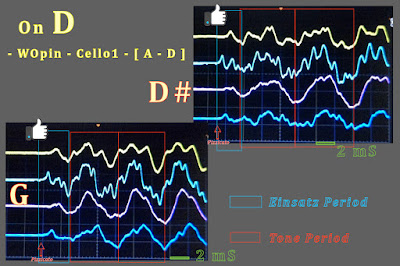[ 4/10/2023 ] Labels: 54.Endpin-Resonance4
Cello's resonance body has remarkable abilities that can resonate all/continuous tones, on the other hand, how the endpins are working? We took a review for endpin resonance including our unpublished data.
Resonance mechanisms of endpins are rather simple. It seems simply like rods or pipes. When the given frequency meets the resonance frequency of rod, endpins resonate well. There seems three mechanisms according to the tone area.
[A] At high tone area, the resonance mainly depends on(or in proportion to) the characteristic frequency as a rod/pipe.
[C] At the lowest tones such as C,C#,D on C string, and placed a cello on the floor, the energy of cello resonance can easily leaks to the floor. Because cello body cannot resonate such a long wavelength in itself. As a result the sound weakens and generates interference beats to the floor. We will review it later again.
[B] The dominant mechanism of endpin resonance seems come from the behavior of rods/pipes (two points fixed) between tail-pin and floor. Some important findings are seen here.
(1) Beats in a cycle period are mesured and colored. Endpins can resonate with given tones as single beat( as a same frequency) only above (around) 220Hz. This fatal competence will bring the modern cello a husky/mechanical sound color.
(2) Diagonal-mountains-valley-like resonance pattern tells us something. "Low tone & long endpin" and "high tone & short endpin" are taking a same mechanical resonance beats. Extra length of endpin is probably taking the initiative to the resonance. Heavy metal endpin shows a clearer tendency.
(3) Endpin resonates well at mountains area and less at valleys, sometimes acting as a mute.
チェロの筐体はあらゆる(連続した)ピッチの音を共鳴・増幅できる画期的構造である。筐体よりもはるかに大きい(長い)波長の低音も高音倍音軌道を組み合わせて作り出すことができる。
一方、エンドピンはどうであろうか?。 未投稿のデータも加えて、エンドピンの共振メカニズムをレビューしておこう。
エンドピンの共振は単純である。基本的に「棒・パイプ」の共振である。周波数が合致すれば共振し、合わなければ共振せず逆に消音効果となる。重いエンドピンほど消音効果は大きく、演奏者にとってレスポンスの悪化となる。
エンドピンの共振メカニズムは大きく3つのエリアによって現れ方が異なるようである。
[A]高音エリアではエンドピンという棒の材質に起因する固有振動が強く影響し、n倍の周波数の位置で特に大きく共振するように見える。
[C]低音(C線のC,C#,D,)では、エンドピンが装着され床置きされると、長波長を筐体が筐体内でとどめることができず物理的に床へのリークが発生する。この時床との軌道と筐体の軌道とに波長差が生じ、床を揺らす振動が起こる場合がある。詳細は後日レビューする。
[B]チェロ音域の多く(広く)で起こっているのは、テールピンと床の2点でエンドピンが固定されるために発生する棒としての共振である。共振トーンとエンドピンの(床までの)長さによる測定結果を見ると、幾つかの特徴があることがわかる。
(1) 1周期内で共振するビート数を見ると、「赤1」で示すエリアは、ほぼA(420Hz)あたりよりも高周波域に限定される。つまりエンドピン共振は C,G,D線域のトーンに対して1ビートで共振できない。つまり細かな高音の均一(機械的)振動として共振する。モダンチェロのツーンとした音の原因をもたなしているようだ。
(2)長いエンドピンで低音のときと、短くしたエンドピンで高音の時とで同じ共振をしている。つまりテールピンと床の2点で固定されている棒の振動であり、チェロ内で目に触れない「余長」部分の振動がイニシャチブを取っていると推定される。質量の大きい金属のエンドピンほど明確な傾向が見られる。
(3)強く共振するエリアが縞状に並んでいる。共振する確率としない確率(ミュートとして働く)確率は、50/50と考えるべきである。











